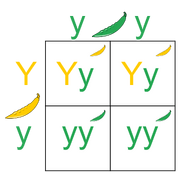Assessment |
Biopsychology |
Comparative |
Cognitive |
Developmental |
Language |
Individual differences |
Personality |
Philosophy |
Social |
Methods |
Statistics |
Clinical |
Educational |
Industrial |
Professional items |
World psychology |
Biological: Behavioural genetics · Evolutionary psychology · Neuroanatomy · Neurochemistry · Neuroendocrinology · Neuroscience · Psychoneuroimmunology · Physiological Psychology · Psychopharmacology (Index, Outline)

A Punnett square showing a typical test cross
The Punnett square is a diagram that is used to predict an outcome of a particular cross or breeding experiment. It is named after Reginald C. Punnett, who devised the approach, and is used by biologists to determine the probability of an offspring's having a particular genotype. The Punnett square is a summary of every possible combination of one maternal allele with one paternal allele for each gene being studied in the cross.[1]
Monohybrid cross[]
- Main article: Monohybrid cross
In this example, both organisms have the genotype Bb. They can produce gametes that contain either the B or the b allele. (It is conventional in genetics to use capital letters to indicate dominant alleles and lower-case letters to indicate recessive alleles.) The probability of an individual offspring's having the genotype BB is 25%, Bb is 50%, and bb is 25%.
| Paternal | |||
|---|---|---|---|
| B | b | ||
| Maternal | B | BB | Bb |
| b | Bb | bb | |
It is important to note that Punnett squares give probabilities only for genotypes, not phenotypes. The way in which the B and b alleles interact with each other to affect the appearance of the offspring depends on how the gene products (proteins) interact (see Mendelian inheritance). For classical dominant/recessive genes, like that which determines whether a rat has black hair (B) or white hair (b), the dominant allele will mask the recessive one. Thus, in the example above, 75% of the offspring will be black (BB or Bb) while only 25% will be white (bb). The ratio of the phenotypes is 3:1, typical for a monohybrid cross.
Dihybrid cross[]
- Main article: Dihybrid cross
More complicated crosses can be made by looking at two or more genes. The Punnett square works, however, only if the genes are independent of each other, which means that having a particular allele of gene X does not imply having a particular allele of gene Y.
The following example illustrates a dihybrid cross between two heterozygous pea plants. R represents the dominant allele for shape (round), while r represents the recessive allele (wrinkled). A represents the dominant allele for color (yellow), while a represents the recessive allele (green). If each plant has the genotype RrAa, and since the alleles for shape and color genes are independent, then they can produce four types of gametes with all possible combinations: RA, Ra, rA, and ra.
| RA | Ra | rA | ra | |
|---|---|---|---|---|
| RA | RRAA | RRAa | RrAA | RrAa |
| Ra | RRAa | RRaa | RrAa | Rraa |
| rA | RrAA | RrAa | rrAA | rrAa |
| ra | RrAa | Rraa | rrAa | rraa |
Since dominant traits mask recessive traits, there are nine combinations that have the phenotype round yellow, three that are round green, three that are wrinkled yellow, and one that is wrinkled green. The ratio 9:3:3:1 is typical for a dihybrid cross.
Tree method[]
Template:Alt text missing
Another way to solve dihybrid and multihybrid crosses is to use the tree method, although it does not display the genotypes of the gametes correctly. File:Dihybrid Cross Tree Method.png
This method is particularly advantageous when crossing homozygous organisms. File:Homozygous cross tree method.png
Template:Expand section
Situations where Punnett squares need to be used with care[]
The phenotypic ratios of 3:1 and 9:3:3:1 are theoretical predictions based on the assumptions of segregation and independent assortment of alleles (see Mendelian inheritance). Deviations from expected ratios can occur if any of the following conditions exists:
- the alleles in question are on the same chromosome and linked
- one parent lacks a copy of the gene; for example, human males have only one X chromosome, from their mother, so only the maternal alleles have an effect on the organism (see sex linkage)
- the survival rate of different genotypes is not the same; for example, one combination of alleles may be incompatible with life so that the affected offspring expires in utero
- alleles may show incomplete dominance or co-dominance (see dominance relationship)
- there are genetic interactions (epistasis) between alleles of different genes
- the trait is inherited on genetic material from only one parent, e.g. mitochondrial DNA is inherited only from the mother (see maternal effect)
- the alleles are imprinted
Notes[]
References[]
- Campbell, Neil. Biology, 7th, Benjamin-Cummings Publishing Company.
External links[]
- Online Punnett Square Calculator
- Online Punnett Square Calculator, monohybrid and dihybrid, autosomal and sex-linked
- Salman Khan's "lecture"
| This page uses Creative Commons Licensed content from Wikipedia (view authors). |